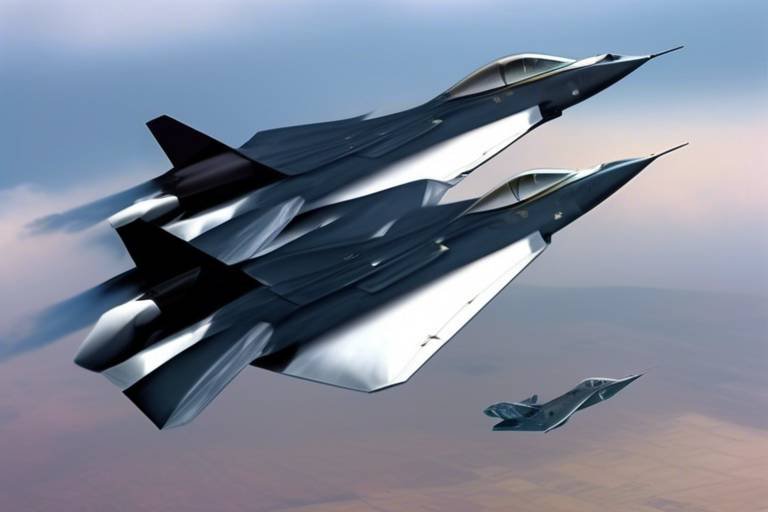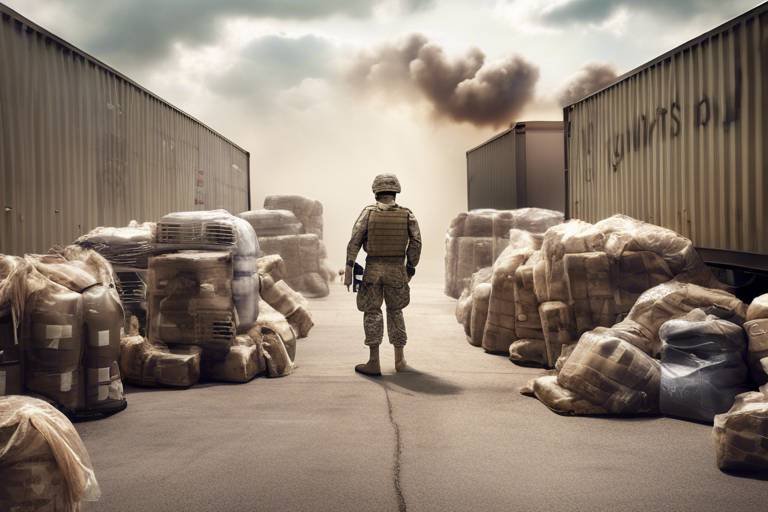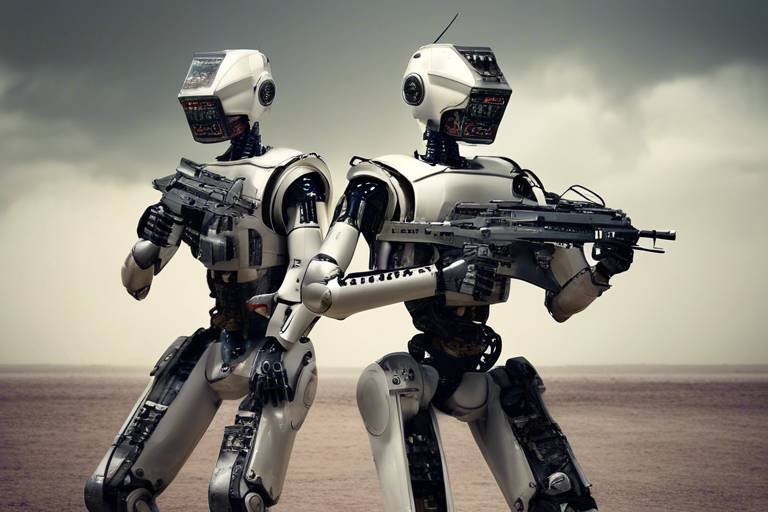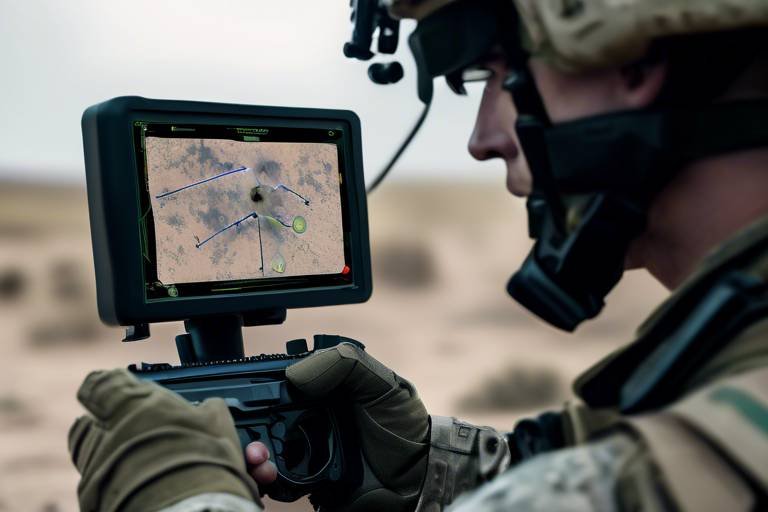The Role of Robotics in Military Humanitarian Aid
In recent years, the landscape of humanitarian aid has been dramatically transformed by the integration of robotics. This technology is not just a futuristic concept; it has become a vital component in military operations aimed at delivering aid during crises. Imagine a world where autonomous drones swoop in to deliver medical supplies to remote villages cut off by natural disasters or ground robots navigate treacherous terrain to transport food and water to those in desperate need. This is not science fiction; this is the reality of robotics in military humanitarian efforts today.
As we delve into this topic, it's essential to recognize the profound impact that robotics has on enhancing efficiency and improving outcomes in crisis situations. Traditional methods of delivering aid can be slow and fraught with challenges, especially in conflict zones or areas affected by natural disasters. However, with the advent of robotic technology, we are witnessing a shift towards more effective and timely humanitarian responses. This article will explore various applications of robotics, the challenges faced, and the promising future that lies ahead in this field.
Robots are not merely tools; they are game-changers. In military humanitarian missions, they can operate in environments that are hazardous for human personnel, thereby reducing risk and maximizing the reach of aid efforts. As we navigate through this exploration, we will discuss the different types of robotics currently in use, including drones, ground vehicles, and underwater robots, and how each plays a pivotal role in humanitarian operations.
Moreover, it's crucial to address the challenges that accompany the implementation of these advanced technologies. From technical limitations to ethical concerns, the integration of robotics into military humanitarian aid is not without its hurdles. However, the potential benefits far outweigh these challenges, opening up a world of possibilities for future humanitarian missions.
Join us as we embark on this journey to uncover the transformative role of robotics in military humanitarian aid, and discover how these innovations are paving the way for a more efficient and effective response to crises around the globe.
- What types of robots are used in military humanitarian aid?
Various types of robots, including drones for aerial surveillance, ground vehicles for logistics, and underwater robots for search and rescue missions, play essential roles in military humanitarian efforts. - How do drones enhance humanitarian missions?
Drones provide real-time data collection, conduct aerial surveys, and can deliver supplies to remote areas, significantly improving situational awareness and decision-making. - What are the ethical concerns regarding the use of robotics in military operations?
Ethical concerns include questions of autonomy, accountability, and the potential for misuse in conflict situations, requiring careful consideration of legal frameworks. - What challenges do robotics face in humanitarian aid?
Challenges include technical limitations in navigation, funding issues, and the need for proper training for personnel operating these technologies. - What does the future hold for robotics in humanitarian aid?
The future looks promising with advancements in artificial intelligence and machine learning, which are expected to enhance the capabilities of robots in humanitarian operations.

Introduction to Robotics in Humanitarian Aid
In recent years, the landscape of humanitarian aid has undergone a significant transformation, largely due to the advent of robotics. These technological marvels are not just the stuff of science fiction; they are becoming indispensable tools in military operations aimed at providing relief during crises. Imagine a world where robots can swiftly navigate through disaster zones, delivering essential supplies while ensuring the safety of human personnel. This is not just a dream—it's happening right now.
Robotics in humanitarian aid encompasses a wide range of applications, from drones that soar above disaster-stricken areas to ground vehicles that traverse treacherous terrains. The importance of these technologies cannot be overstated, as they enhance the efficiency of aid delivery and improve the overall outcomes of military humanitarian missions. In situations where time is of the essence, such as natural disasters or conflict zones, the ability to deploy robots can mean the difference between life and death.
Moreover, the integration of robotics into military humanitarian efforts allows for a more strategic approach. By leveraging real-time data collected by drones and ground robots, military forces can make informed decisions that maximize the impact of their interventions. For instance, drones equipped with advanced imaging technology can provide a comprehensive overview of affected areas, allowing commanders to assess damage and prioritize resources effectively.
However, the journey towards fully utilizing robotics in humanitarian aid is not without its challenges. As we explore the various types of robots and their specific applications, it's essential to consider the ethical implications and technical hurdles that accompany this technological revolution. As we delve deeper into the world of robotics in humanitarian aid, we will uncover the multifaceted roles these machines play and the future possibilities they hold.
In summary, the intersection of robotics and humanitarian aid is a fascinating realm that is continuously evolving. With each advancement in technology, we are one step closer to a future where military forces can respond to crises with unprecedented speed and efficiency. As we move forward, the integration of robotics into humanitarian efforts will not only enhance operational capabilities but also redefine how we approach aid delivery in the most challenging environments.
- What types of robots are commonly used in humanitarian aid? Drones, ground vehicles, and underwater robots are among the most common types utilized in military humanitarian operations.
- How do drones improve situational awareness in disaster zones? Drones provide real-time aerial surveillance, allowing for better assessment of damage and resource allocation.
- What are some challenges faced in implementing robotics for humanitarian aid? Technical limitations, ethical concerns, and funding issues are significant challenges that need to be addressed.
- What is the future of robotics in military humanitarian efforts? Advances in artificial intelligence and machine learning are expected to enhance the capabilities and applications of robotics in this field.
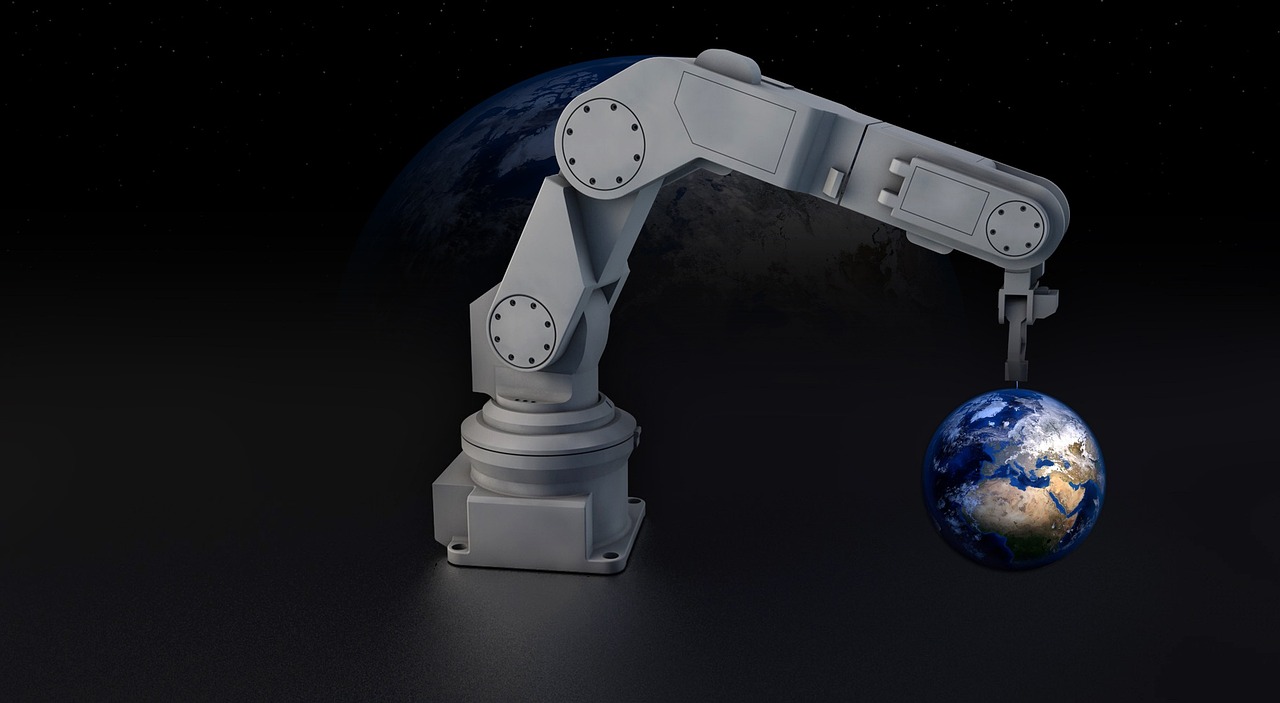
Types of Robotics Used
In the realm of military humanitarian aid, robotics has carved out a significant niche, transforming how assistance is delivered in times of crisis. The integration of various robotic technologies is not just a trend; it's a revolution that enhances operational efficiency and effectiveness. So, what types of robotics are making waves in this field? Let's dive into the most prominent categories: drones, ground vehicles, and underwater robots. Each of these types serves unique purposes and plays a critical role in ensuring that aid reaches those in need.
Drones are perhaps the most recognizable form of robotics used in humanitarian efforts. They come in many shapes and sizes, but their primary function revolves around aerial surveillance and delivery. For instance, drones equipped with high-resolution cameras can gather real-time data, providing crucial situational awareness to military personnel and aid workers. This capability allows for informed decision-making in rapidly changing environments, which is vital during emergencies. Moreover, drones can also deliver supplies directly to remote or inaccessible areas, cutting down on the time it takes to provide assistance.
When it comes to aerial surveillance, drones are invaluable. They can cover vast areas quickly, capturing images and data that would take teams of people days to collect. Imagine a drone soaring over a disaster zone, sending back live footage that helps assess the damage and identify the most urgent needs. This real-time information is a game-changer in humanitarian missions. Not only does it enhance situational awareness, but it also allows for better resource allocation, ensuring that aid reaches those who need it most.
Delivery drones take this a step further by transporting essential medical supplies and food directly to those in need. Picture a scenario where a natural disaster has struck a remote village. Roads are blocked, and traditional means of transport are rendered ineffective. In such cases, delivery drones can swoop in, bypassing obstacles and ensuring that life-saving supplies reach their destination swiftly. Studies have shown that using drones for delivery can significantly reduce the time it takes to get aid to affected populations, making them a crucial asset in emergency situations.
Another fascinating application of drones is in mapping and reconnaissance. Robots equipped with advanced mapping technology can create detailed maps of disaster-stricken areas, helping to identify safe routes for ground vehicles and personnel. This capability is essential for planning effective humanitarian responses. For example, after an earthquake, mapping drones can quickly assess which roads are passable and which areas are most affected, facilitating a more organized and efficient response. By leveraging these technological advancements, military forces can navigate complex environments with greater ease and safety.
While drones often steal the spotlight, ground robots are equally important in military humanitarian operations. These robots are designed to assist in logistical support, transporting supplies and aiding personnel on the ground. Imagine a rugged robot capable of traversing rough terrain, carrying essential goods while freeing up human resources for more critical tasks. Ground robots can operate in environments that may be hazardous for humans, such as areas with potential landmines or chemical spills. Their ability to navigate and transport materials makes them invaluable assets in crisis situations.
In summary, the types of robotics used in military humanitarian aid are diverse and tailored to meet specific needs. From drones providing aerial surveillance and delivery to ground robots enhancing logistics, each robotic technology plays a pivotal role in improving humanitarian efforts. As these technologies continue to evolve, we can expect even greater efficiency and effectiveness in delivering aid when it matters most.
- What are the main types of robots used in military humanitarian aid?
Drones, ground vehicles, and underwater robots are the primary types of robotics in this field. - How do drones enhance situational awareness?
Drones provide real-time data and imagery, allowing for informed decision-making in crisis situations. - What role do ground robots play in humanitarian operations?
Ground robots assist in logistics by transporting supplies and aiding personnel, especially in hazardous environments. - Are there any ethical concerns regarding the use of robots in humanitarian aid?
Yes, the use of robotics raises questions about autonomy, accountability, and the potential for misuse.

Drones for Aerial Surveillance
Drones have revolutionized the way we approach humanitarian missions, particularly in military contexts. These unmanned aerial vehicles (UAVs) are not just flying gadgets; they are robust tools that enhance situational awareness and improve decision-making processes in crisis situations. Imagine being in a disaster-stricken area where traditional communication lines are down, and roads are impassable. In such scenarios, drones can swoop in, providing a bird's-eye view of the landscape, which is invaluable for assessing the situation.
One of the primary functions of drones in aerial surveillance is their ability to collect real-time data. Equipped with high-resolution cameras and sensors, they can capture images and videos that help military personnel understand the extent of damage and the needs of the affected population. For instance, after a natural disaster, drones can quickly survey the affected area, identifying hotspots where aid is urgently required. This capability allows for a more targeted and efficient response, ensuring that resources are allocated where they are most needed.
Moreover, drones can operate in environments that are too dangerous for human first responders. In conflict zones or areas with ongoing threats, deploying a drone can provide critical information without risking lives. This ability to conduct reconnaissance without putting personnel in harm's way is one of the significant advantages of using drones in military humanitarian operations.
Furthermore, the integration of advanced technologies such as artificial intelligence (AI) into drone systems enhances their functionality. AI can analyze the data collected by drones, identifying patterns and making recommendations for action. This not only speeds up the decision-making process but also increases the overall effectiveness of humanitarian missions.
In summary, drones for aerial surveillance represent a leap forward in how military forces engage in humanitarian efforts. Their ability to provide real-time data, operate in hazardous environments, and utilize advanced technology makes them indispensable tools in contemporary crisis management. As we continue to explore the potential of robotics in humanitarian aid, it is clear that drones will play a pivotal role in shaping future missions.
- What types of drones are used for aerial surveillance in humanitarian missions?
Various types of drones are utilized, including fixed-wing drones for long-range missions and quadcopters for detailed, close-range surveys. - How do drones improve response times in emergencies?
Drones can quickly gather information and assess damage, allowing military and humanitarian teams to deploy resources more effectively and efficiently. - Are there any risks associated with using drones in humanitarian aid?
Yes, potential risks include privacy concerns, technical malfunctions, and the need for regulatory compliance in different regions.
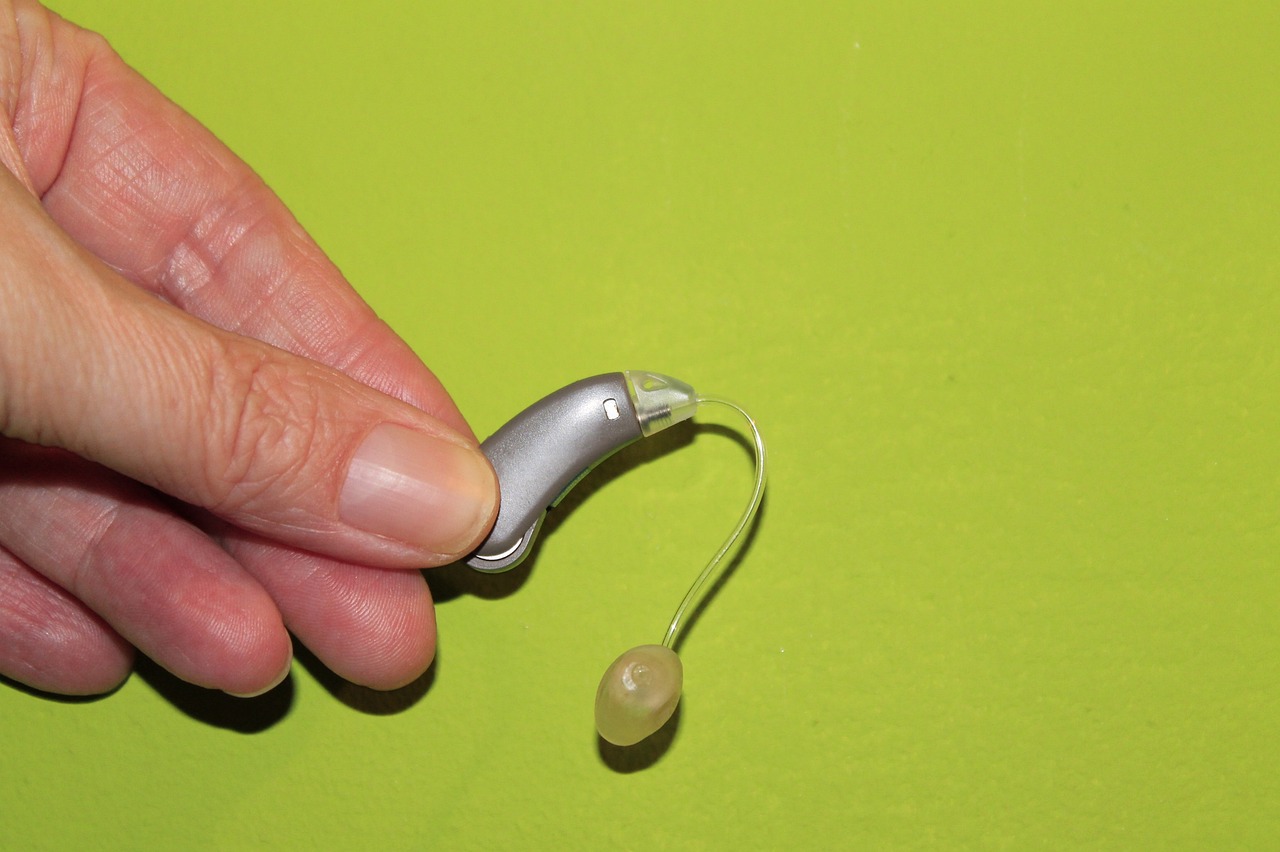
Delivery Drones
When it comes to delivering aid in crisis situations, have emerged as a game-changer. Imagine a world where medical supplies, food, and essential resources can be transported to the most remote and hard-to-reach areas in a matter of minutes. That's the reality that delivery drones are creating today. These flying robots are not just about speed; they are also about precision and efficiency, making them invaluable in military humanitarian missions.
Delivery drones are equipped with advanced navigation systems that allow them to fly over challenging terrains, including mountains, forests, and urban landscapes. This capability is crucial during emergencies when traditional transportation methods might be hindered by damaged infrastructure or hazardous conditions. For instance, in the aftermath of a natural disaster, roads may be impassable, but drones can soar above the wreckage, ensuring that help reaches those in desperate need.
One of the most significant advantages of using delivery drones is their ability to operate autonomously. With the integration of artificial intelligence and machine learning, these drones can make real-time decisions based on environmental data. They can identify the safest and most efficient flight paths, avoiding obstacles and adjusting to changing weather conditions. This level of autonomy not only enhances the speed of delivery but also reduces the risk to human operators.
Furthermore, the impact of delivery drones extends beyond just speed. They can carry a variety of payloads, including:
- Medical supplies such as vaccines and first-aid kits
- Food and water for affected populations
- Communication devices to establish contact in remote areas
In many cases, these drones are capable of delivering supplies to multiple locations in a single mission, significantly increasing the efficiency of humanitarian operations. For example, during a recent military-led humanitarian mission, drones successfully delivered over 500 pounds of aid to several isolated villages within just a few hours. This type of rapid response is critical in saving lives and alleviating suffering during emergencies.
However, the deployment of delivery drones is not without its challenges. Issues such as regulatory hurdles, airspace management, and privacy concerns need to be addressed to ensure their effective use. As drone technology continues to evolve, it is essential for military organizations and humanitarian agencies to collaborate with regulatory bodies to create frameworks that facilitate safe and responsible drone operations.
In conclusion, delivery drones are revolutionizing the way humanitarian aid is delivered in military operations. Their ability to navigate complex environments, operate autonomously, and carry diverse payloads makes them an indispensable tool in crisis situations. As technology advances and challenges are addressed, we can expect to see even greater integration of delivery drones in humanitarian missions, ultimately leading to improved outcomes for those in need.
- What types of supplies can delivery drones transport?
Delivery drones can carry a variety of items, including medical supplies, food, water, and communication devices. - How do delivery drones navigate during missions?
Delivery drones use advanced navigation systems and artificial intelligence to identify safe flight paths and avoid obstacles. - What challenges do delivery drones face in humanitarian operations?
Challenges include regulatory hurdles, airspace management, and privacy concerns that need to be addressed for effective deployment.

Mapping and Reconnaissance
In the chaotic aftermath of a disaster, understanding the terrain and assessing damage are crucial for effective humanitarian response. This is where mapping and reconnaissance robots come into play, acting as the eyes and ears of military forces deployed in crisis situations. Equipped with advanced sensors and imaging technology, these robots can navigate challenging environments, providing real-time data that is vital for planning and executing relief efforts. Imagine having a bird's-eye view of a disaster zone, pinpointing areas that need immediate attention, all without putting human lives at risk. That's the power of robotics in mapping and reconnaissance!
These robots utilize a variety of technologies to create detailed maps and gather intel. For instance, GPS systems and LiDAR (Light Detection and Ranging) are often integrated into their design, allowing them to generate accurate three-dimensional maps of affected areas. This data is not just useful for immediate response; it also aids in long-term recovery planning. By understanding the landscape, military personnel can identify safe routes for delivering aid, locate shelters for displaced individuals, and assess the overall impact of the disaster.
One of the standout features of reconnaissance robots is their ability to operate in environments that are too dangerous for humans. For example, in the aftermath of an earthquake, buildings may be unstable, and there could be hazardous materials present. By sending in a robot equipped with cameras and sensors, teams can gather essential information without risking human lives. This capability is not only about safety; it also speeds up the decision-making process, allowing for quicker responses to urgent needs.
Furthermore, the data collected by these robots can be analyzed and shared in real-time with command centers, improving situational awareness. The integration of artificial intelligence into these systems is paving the way for even more advanced capabilities. Imagine a robot that can not only map an area but also identify potential hazards or assess the condition of infrastructure autonomously. This kind of technology could revolutionize how military humanitarian operations are conducted.
In summary, mapping and reconnaissance robots are indispensable tools in military humanitarian aid. They enhance situational awareness, improve safety, and enable more effective planning and execution of relief efforts. As technology continues to evolve, the potential for these robots to transform humanitarian missions is truly exciting. The future holds endless possibilities for how we can leverage robotics to save lives and restore communities in their time of need.
- What types of robots are used for mapping and reconnaissance?
Various types of robots, including drones and ground vehicles, are utilized for mapping and reconnaissance in humanitarian missions. Drones provide aerial views, while ground robots can navigate challenging terrains. - How do these robots improve safety during humanitarian operations?
By deploying robots in hazardous environments, military forces can gather crucial information without risking human lives, ensuring safer operations in disaster-stricken areas. - What technologies are integrated into mapping robots?
Mapping robots often use GPS, LiDAR, and imaging technology to create accurate maps and gather real-time data for analysis. - Can these robots operate autonomously?
Yes, advancements in artificial intelligence are enabling robots to operate autonomously, making decisions based on the data they collect to improve efficiency in humanitarian efforts.

Ground Robots for Logistics
In the realm of military humanitarian aid, ground robots are revolutionizing the way logistics are managed. Imagine a world where supplies can be transported swiftly and safely to those in dire need, all thanks to the ingenuity of robotics. Ground robots are designed to navigate challenging terrains, ensuring that essential goods reach their destinations without delay. These machines are not just tools; they are lifelines in crisis situations, enabling military personnel to focus on what truly matters: saving lives.
One of the most compelling features of ground robots is their ability to operate in environments that are often hazardous for humans. For instance, during natural disasters, traditional logistics can be hampered by debris, floods, or unstable structures. Ground robots, equipped with advanced sensors and navigation systems, can maneuver through these obstacles, delivering food, medical supplies, and other critical resources directly to affected areas. This capability not only enhances efficiency but also significantly reduces the risks faced by human operators.
Moreover, ground robots come in various forms, each tailored to specific logistical tasks. Some are designed for transportation, while others may specialize in surveillance or reconnaissance. For example, a robot like the PackBot can carry heavy loads over rough terrain, while others may be equipped with cameras and mapping technology to assess conditions and relay information back to command centers. The versatility of these machines is a game-changer in military operations, as they can be rapidly deployed and adapted to meet the evolving needs of humanitarian missions.
To illustrate the impact of ground robots in logistics, consider the following table that highlights their key functionalities:
| Robot Type | Functionality | Example |
|---|---|---|
| Transport Robots | Carry supplies and equipment to remote locations | PackBot |
| Reconnaissance Robots | Survey areas and gather intelligence | Talons |
| Surveillance Robots | Monitor situations and provide real-time data | Robot Dog |
As we continue to explore the capabilities of ground robots, it's essential to recognize their role in enhancing collaboration between military and humanitarian efforts. These robots not only streamline operations but also foster a sense of safety and security for both aid workers and the communities they serve. By reducing the logistical burdens, ground robots allow military personnel to engage more directly with affected populations, providing much-needed support and assistance.
In conclusion, ground robots are reshaping the logistics landscape in military humanitarian aid. Their ability to navigate through difficult environments, coupled with their diverse functionalities, makes them indispensable in crisis response scenarios. As technology continues to advance, we can only anticipate even greater innovations that will further enhance the effectiveness of these robotic systems in saving lives and delivering aid where it is needed most.
- What types of ground robots are used in military humanitarian aid? Ground robots can include transport robots, reconnaissance robots, and surveillance robots, each designed for specific tasks in logistics and support.
- How do ground robots navigate challenging terrains? Ground robots are equipped with advanced sensors and navigation systems that allow them to detect obstacles and adjust their paths accordingly.
- Can ground robots operate autonomously? Many ground robots have autonomous capabilities, allowing them to perform tasks with minimal human intervention, which is crucial in hazardous environments.
- What is the future of ground robots in humanitarian aid? The future looks promising, with ongoing advancements in technology that will enhance the capabilities and efficiency of ground robots in logistics.

Challenges in Implementation
While the integration of robotics into military humanitarian aid presents a world of opportunities, it is not without its fair share of challenges. Imagine trying to navigate a ship through a storm without a compass; that’s somewhat akin to how military forces feel when deploying robotics in crisis situations. The technical limitations, ethical concerns, and funding issues can create a turbulent environment that hinders the effectiveness of these high-tech tools.
One of the primary hurdles is the technical limitations associated with robotic systems. These machines often struggle in complex environments, such as densely populated urban areas or rugged terrains. For instance, a drone might excel at aerial surveillance in open fields but can find it challenging to navigate through narrow alleys or around obstacles. This limitation can severely impact their operational efficiency. Ongoing research is focused on enhancing navigation algorithms, improving sensor technologies, and developing more adaptable robotic systems to overcome these challenges. However, until these advancements are realized, the full potential of robotics in humanitarian aid remains constrained.
Additionally, the ethical and legal considerations surrounding the use of robotics in military operations cannot be overlooked. Questions of autonomy and accountability arise when machines are tasked with critical decisions during humanitarian missions. If a robot makes a mistake—say, misidentifying a target or failing to deliver aid to the right location—who is held responsible? The military, the manufacturers, or the programmers? These ethical dilemmas necessitate the establishment of clear legal frameworks to guide the use of robotics in humanitarian contexts. This is no small feat, as it requires collaboration among governments, legal experts, military officials, and ethicists.
Moreover, funding issues present another significant challenge. Developing and deploying advanced robotic systems requires substantial financial investment. Military budgets are often stretched thin, and allocating funds specifically for robotics can be a hard sell. This leads to a scenario where only a limited number of projects receive the necessary funding, leaving many innovative ideas untested. The challenge is not just in securing funds but also in demonstrating the return on investment that these robotic systems can provide in humanitarian efforts.
Despite these challenges, the integration of robotics into military humanitarian aid is a journey worth undertaking. By addressing these issues head-on, military forces can harness the full potential of robotic technology to enhance their response capabilities in crisis situations. The path may be fraught with obstacles, but overcoming them can lead to a future where humanitarian aid is delivered more efficiently and effectively than ever before.
- What are the main challenges faced in implementing robotics in military humanitarian aid?
The main challenges include technical limitations, ethical and legal considerations, and funding issues.
- How do technical limitations affect the use of robotics?
Technical limitations can hinder navigation and operational efficiency, especially in complex environments.
- Why are ethical considerations important in military robotics?
Ethical considerations are crucial to ensure accountability and responsible use of autonomous systems in humanitarian missions.
- How can funding issues impact robotics projects?
Funding issues can limit the development and deployment of innovative robotic solutions, affecting their effectiveness in humanitarian aid.

Technical Limitations
While the integration of robotics into military humanitarian aid has shown tremendous potential, it is not without its . One of the most pressing challenges is the ability of robots to navigate in complex and unpredictable environments. Imagine a drone trying to deliver supplies in a densely populated area that has been ravaged by a natural disaster; the debris, damaged buildings, and chaotic human activity can create a maze that is difficult for any autonomous system to navigate. Current technology often struggles with real-time obstacle detection and avoidance, which can lead to delays in aid delivery or, worse, accidents that could hinder operations.
Another significant limitation is the battery life of robotic systems. Many drones and ground robots rely on batteries that have a limited operational time. In a humanitarian crisis, where every second counts, the last thing you want is for a robot to run out of power before completing its mission. This constraint not only affects the range and endurance of these machines but also necessitates frequent recharging or battery swapping, which can be logistically challenging, especially in remote areas.
Furthermore, the communication networks that robots depend on can be unreliable in crisis situations. In many instances, such as during earthquakes or floods, existing communication infrastructure may be damaged or nonexistent. This disruption can severely limit the effectiveness of robotic systems, which often rely on cloud computing and real-time data sharing to operate efficiently. Without a stable connection, robots may be unable to receive critical updates or relay information back to their human operators, thereby hindering situational awareness and decision-making.
To illustrate these challenges, consider the following table that summarizes some of the key technical limitations faced by robotic systems in military humanitarian aid:
| Technical Limitation | Description |
|---|---|
| Navigation Challenges | Difficulty in maneuvering through complex and debris-filled environments. |
| Battery Life | Limited operational time requiring frequent recharging or battery swaps. |
| Communication Reliability | Dependence on stable networks which may be compromised in crisis situations. |
Lastly, there is the issue of interoperability among different robotic systems. Various military and humanitarian organizations may deploy different types of robots, each with unique software and hardware specifications. This lack of standardization can lead to complications when trying to coordinate efforts across multiple agencies. For instance, if one organization uses drones that cannot communicate with ground robots from another organization, it creates a divide that can slow down the response to a humanitarian crisis.
In conclusion, while robotics holds immense promise for enhancing military humanitarian aid, it is crucial to address these technical limitations. Ongoing research and development efforts are focused on improving navigation systems, extending battery life, enhancing communication protocols, and fostering interoperability among different robotic platforms. By overcoming these challenges, we can ensure that robots become a more reliable and effective component of humanitarian operations.
- What are the main technical limitations of robotics in humanitarian aid?
Robotics face challenges such as navigation in complex environments, limited battery life, unreliable communication networks, and interoperability issues among different systems. - How do navigation challenges affect humanitarian missions?
Navigation issues can lead to delays in aid delivery and potential accidents, especially in chaotic environments like disaster zones. - What is being done to improve the battery life of robots?
Research is ongoing to develop more efficient battery technologies and alternative power sources to extend operational time. - Why is communication reliability important for robotic systems?
Reliable communication ensures that robots can receive critical updates and relay information back to operators, which is essential for effective decision-making in crisis situations.

Ethical and Legal Considerations
The integration of robotics into military humanitarian aid raises a myriad of ethical and legal considerations. As we deploy these advanced technologies to assist in crisis situations, we must grapple with questions surrounding autonomy, accountability, and the potential for unintended consequences. For instance, when a robot makes a decision in a high-stakes environment, who is responsible for that decision? Is it the programmer, the military, or the robot itself? These questions are not merely academic; they have real-world implications that can affect lives.
One of the primary ethical dilemmas involves the autonomy of robotic systems. As robots become increasingly capable of making decisions without human intervention, the risk of errors or misjudgments rises. Imagine a delivery drone mistakenly identifying a target during a humanitarian mission due to a software glitch. This scenario highlights the urgent need for clear guidelines and accountability measures. Furthermore, the use of autonomous systems in military operations could lead to a desensitization of personnel to violence and suffering, as the human element is diminished.
In addition to ethical concerns, there are significant legal frameworks that govern the use of robotics in military operations. International humanitarian law, which aims to limit the effects of armed conflict, must be considered when deploying robots in crisis zones. Questions arise regarding compliance with these laws, especially when robots are involved in activities that could be interpreted as combat. To navigate these complexities, military forces must ensure that their robotic systems are programmed to adhere to existing legal standards, which may require sophisticated algorithms capable of interpreting complex legal guidelines.
Moreover, the deployment of robotic technologies in humanitarian aid must also consider privacy issues. Drones conducting surveillance may inadvertently capture sensitive personal data, raising concerns about the rights of individuals in affected areas. The balancing act between gathering vital information for aid delivery and respecting the privacy of civilians is a challenging yet necessary endeavor.
To address these multifaceted challenges, a collaborative approach is essential. Engaging a diverse group of stakeholders—including ethicists, legal experts, military personnel, and humanitarian organizations—can foster a more comprehensive understanding of the implications of robotics in military humanitarian aid. This collaborative effort can lead to the establishment of ethical guidelines and legal frameworks that ensure the responsible use of technology in crisis scenarios.
In summary, while robotics holds immense potential to enhance military humanitarian efforts, it is imperative to navigate the ethical and legal landscape carefully. By addressing these considerations proactively, we can leverage technology to save lives while maintaining the integrity of humanitarian principles.
- What are the main ethical concerns regarding robotics in humanitarian aid?
Ethical concerns include autonomy in decision-making, accountability for actions taken by robots, and the potential desensitization to violence. - How does international law apply to the use of robots in military operations?
International humanitarian law governs the conduct of war and must be adhered to by robotic systems to ensure compliance with legal standards. - What role do privacy issues play in the deployment of surveillance drones?
Drones may collect personal data unintentionally, raising concerns about the rights of individuals in affected areas. - How can stakeholders collaborate to address these ethical and legal challenges?
Engaging ethicists, legal experts, military personnel, and humanitarian organizations can lead to the development of guidelines that ensure responsible technology use.

The Future of Robotics in Humanitarian Aid
The future of robotics in military humanitarian aid is not just bright; it's dazzlingly transformative. As we stand on the brink of a technological revolution, advancements in artificial intelligence (AI) and machine learning are set to redefine how military forces respond to crises. Imagine a world where robots not only assist in delivering aid but also analyze situations in real-time, making decisions that save lives. This is not science fiction; it's the reality that is unfolding before our eyes.
One of the most exciting prospects is the development of autonomous robots that can operate without human intervention. These robots could navigate hazardous environments, assess damage, and even deliver supplies in situations where human access is limited or too dangerous. For instance, in the aftermath of a natural disaster, an autonomous ground robot could traverse through rubble, identifying trapped individuals and relaying critical information back to rescue teams. This level of efficiency could drastically reduce response times and improve overall outcomes.
Moreover, the integration of AI technology can enhance the decision-making process. By analyzing vast amounts of data from various sources—such as satellite imagery, social media reports, and on-ground assessments—AI algorithms can provide military personnel with actionable insights. This means that instead of relying solely on human intuition, commanders can make data-driven decisions that are more likely to lead to successful humanitarian outcomes.
As we look to the future, we can also expect to see advancements in collaborative robotics, where multiple robots work together seamlessly. Picture a scenario where drones, ground vehicles, and underwater robots coordinate efforts to deliver aid. Drones could survey the area, while ground robots transport supplies, and underwater robots could assist in flood scenarios by monitoring water levels. This level of collaboration could revolutionize how aid is distributed, making operations faster and more effective.
However, it's essential to recognize that with great power comes great responsibility. As we embrace these technological advancements, we must also address the ethical implications of using robotics in humanitarian aid. Questions about accountability, autonomy, and the potential for misuse must be thoroughly examined. Establishing a robust legal framework will be crucial to ensure that these technologies are used responsibly and ethically.
In summary, the future of robotics in military humanitarian aid is filled with potential. With ongoing advancements in AI, machine learning, and collaborative robotics, we are on the verge of a new era in crisis response. As we harness these technologies, we must remain vigilant about the ethical considerations, ensuring that the primary focus remains on saving lives and alleviating suffering.
- What types of robots are being used in humanitarian aid? Various types, including drones for aerial surveillance, ground robots for logistics, and underwater robots for marine assessments.
- How does AI enhance the capabilities of humanitarian robots? AI allows robots to analyze data, make informed decisions, and operate autonomously in complex environments.
- What are the ethical concerns surrounding the use of robotics in military humanitarian efforts? Key concerns include accountability for actions taken by autonomous robots and the potential for misuse in military operations.
- Will robots replace human aid workers? While robots can enhance efficiency, they are designed to assist, not replace, human compassion and decision-making in humanitarian efforts.

This article explores how robotics is transforming military humanitarian efforts, enhancing efficiency, and improving outcomes in crisis situations. We will discuss various applications, challenges, and future prospects of robotic technology in this field.
Robotics has emerged as a crucial tool in humanitarian operations, enabling military forces to deliver aid more effectively. The integration of robotic technology into humanitarian missions is not just a trend; it's a revolution that enhances the speed and precision of aid delivery. Imagine a world where drones can deliver medical supplies to remote areas, or ground robots can navigate through rubble to find survivors. This is the future of humanitarian aid, and it's happening now. The significance of robotics in military humanitarian efforts cannot be overstated, as it brings a level of efficiency that traditional methods simply cannot match.
Various types of robots are employed in military humanitarian aid, including drones, ground vehicles, and underwater robots. Each of these robotic types has specific applications tailored to meet the demands of different crisis scenarios. For instance, drones are the eyes in the sky, providing real-time surveillance and data collection, while ground robots act as the workhorses, transporting supplies and assisting personnel on the ground. The versatility of these robotic systems is what makes them indispensable in modern humanitarian operations.
Drones play a vital role in collecting real-time data and conducting aerial surveys. In humanitarian missions, situational awareness is crucial. Drones equipped with high-resolution cameras can capture images and videos from above, allowing military personnel to assess the situation without putting themselves in harm's way. This capability significantly enhances decision-making processes, enabling quicker and more informed responses to crises. Furthermore, the ability to cover large areas in a short time frame means that potential threats can be identified early, allowing for proactive measures to be taken.
Delivery drones are utilized to transport medical supplies and food to remote areas. In emergencies, time is of the essence, and these drones have proven to be efficient and effective in providing timely assistance. Imagine a disaster-stricken area where roads are blocked, and traditional vehicles cannot reach those in need. Delivery drones swoop in, bypassing obstacles and delivering essential supplies directly to those who require them most. Their agility and speed can mean the difference between life and death, making them a critical component of modern humanitarian efforts.
Robots equipped with mapping technology are essential for reconnaissance missions. They help identify safe routes and assess damage in disaster-stricken areas. By utilizing advanced sensors and mapping software, these robots can create detailed maps of affected regions, highlighting areas of concern and potential hazards. This information is invaluable for military personnel who must navigate complex environments while ensuring the safety of both their teams and the civilians they aim to assist.
Ground robots are increasingly used for logistical support in military humanitarian operations. These machines can transport supplies, navigate through difficult terrains, and even assist personnel in various tasks. The efficiency of ground robots reduces the physical burden on human workers, allowing them to focus on more critical aspects of the mission. Furthermore, these robots can operate in environments that may be dangerous for humans, such as areas with unexploded ordnance or hazardous materials.
While robotics offers significant advantages, there are challenges to overcome, including technical limitations, ethical concerns, and funding issues. The integration of robotic technology into military humanitarian aid is not without its hurdles. For instance, technical limitations such as navigation in complex environments can hinder the effectiveness of these robots. Additionally, ethical and legal considerations surrounding the use of autonomous machines in military operations raise important questions about accountability and decision-making.
Robots face various technical challenges, such as navigation in complex environments. Current limitations include issues with obstacle avoidance and the ability to operate in extreme weather conditions. Ongoing research is focused on improving robotic capabilities, ensuring that these machines can perform effectively in diverse and challenging scenarios. The development of advanced algorithms and machine learning techniques holds promise for overcoming these obstacles, paving the way for more effective robotic assistance in humanitarian missions.
The use of robotics in military operations raises ethical questions regarding autonomy and accountability. As robots become more autonomous, the question of who is responsible for their actions comes to the forefront. Legal frameworks must evolve to address these concerns, ensuring that the deployment of robots in humanitarian aid aligns with international laws and ethical standards. This delicate balance between technological advancement and ethical responsibility is crucial for the future of robotics in military operations.
The future of robotics in military humanitarian aid looks promising, with advancements in artificial intelligence and machine learning. As these technologies continue to evolve, we can expect to see even more innovative applications of robotics in crisis situations. Imagine robots that can learn from their environments, adapt to changing conditions, and make real-time decisions based on data analysis. The potential for improving humanitarian efforts is immense, and as we embrace these advancements, we move closer to a world where aid can be delivered more efficiently and effectively than ever before.
- What types of robots are commonly used in military humanitarian aid?
Drones, ground vehicles, and underwater robots are commonly utilized for various tasks, including surveillance, logistics, and delivery of supplies. - How do drones enhance situational awareness in humanitarian missions?
Drones provide real-time data and aerial surveys, allowing military personnel to assess situations without risking human lives. - What are the main challenges of implementing robotics in humanitarian aid?
Challenges include technical limitations, ethical concerns, and funding issues that can affect the deployment and effectiveness of robotic systems. - What is the future outlook for robotics in humanitarian efforts?
With advancements in AI and machine learning, the future looks bright, promising more efficient and effective aid delivery systems.
Frequently Asked Questions
- What are the main types of robots used in military humanitarian aid?
The main types of robots used in military humanitarian aid include drones, ground vehicles, and underwater robots. Each type serves unique purposes, such as aerial surveillance, logistics, and mapping in disaster-stricken areas, enhancing the efficiency of aid delivery.
- How do drones enhance humanitarian efforts?
Drones significantly improve humanitarian efforts by providing real-time data through aerial surveys. They help in mapping areas affected by disasters, conducting reconnaissance to identify safe routes, and even delivering essential supplies to remote locations, ensuring timely assistance during emergencies.
- What are the challenges faced in implementing robotics for humanitarian aid?
While robotics offers numerous advantages, there are several challenges to consider, such as technical limitations in navigation and operation, ethical concerns regarding autonomy and accountability, and funding issues that can hinder the deployment and development of robotic technologies in humanitarian missions.
- What ethical considerations arise from using robots in military operations?
The use of robots in military operations raises important ethical questions, particularly regarding autonomy and accountability. It is crucial to establish clear legal frameworks to address these dilemmas, ensuring that robots are used responsibly and ethically in humanitarian contexts.
- What does the future hold for robotics in humanitarian aid?
The future of robotics in humanitarian aid looks bright, with advancements in artificial intelligence and machine learning paving the way for more sophisticated and capable robots. Innovations may lead to even greater efficiency in aid delivery and improved outcomes in crisis situations, revolutionizing how humanitarian efforts are conducted.


